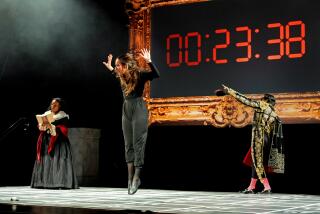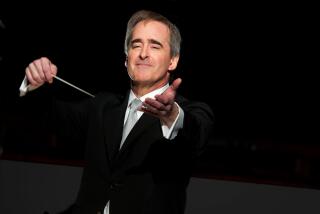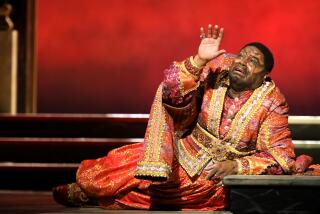Review: ‘War of the Worlds’: Delirious opera rises from the death and destruction of L.A.
When the Los Angeles Philharmonic got the curious notion it needed another opera director on its payroll (Peter Sellars had been the first in the 1990s), it gave Yuval Sharon the vague title of “artist-collaborator” last season, after he rejected “disrupter at large” as having become too conventionally corporate. What Sharon really is is an opera-tor at large. He turns whatever he touches, and wherever he wanders, into opera, whether it wants to be or not.
So here’s what you need to know about the heavily hyped “War of the Worlds” that Sharon mounted at the Walt Disney Concert Hall on Sunday afternoon for the L.A. Phil, in collaboration with his own massively disruptive opera company, the Industry, and the nonprofit Now Art L.A. A new opera and new kind of opera by Annie Gosfield, it does everything an opera’s supposed to. It does a lot opera’s not supposed to do. That includes immersive opera, one of Sharon’s specialties as the mastermind of “Hopscotch,” the celebrated opera in autos two years ago.
There are two more performances of “War of the Worlds,” both on Saturday afternoon as part of the L.A. Phil new music marathon Noon to Midnight. Stop reading and go straight the L.A. Phil website and nab any seat you can find (tickets start at $25).
On the most basic level, this is a fairly straightforward operatic adaption and update of Orson Welles’ famous 1938 radio broadcast, based on H.G. Wells’ science-fiction novel “The War of the Worlds.” At a time when radio broadcasts were beginning to be interrupted by news flashes, Welles treated the play as an ordinary dance-band radio program with increasingly frightening bulletins of an alien invasion.
The brilliantly theatrical night-before-Halloween prank caused panic among some gullible listeners, giving credence to Russian futurist Velimir Khlebnikov’s prediction that radio had the power to become the Great Sorcerer. Sharon sees the panic as an early-warning sign of the imposing threat of fake news.
Riffing on the radio show, this “War of the Worlds” begins as a symphony concert, albeit one with a celebrity host, Sigourney Weaver. The opera will eventually take over the concert, which is meant to include Gosfield’s new celestial orchestral cycle to commemorate the 100th anniversary of Holst’s “The Planets.”
The program book has elaborately descriptive program notes by one Alastair Featherbottom, of the new nine-planet suite, which begins with “Mercury, the Trickster.” A bass (James Hayden) is part of the languorously sexy “Venus” movement that follows, offering camp intimations of some bisexual Elvis business. We get no further (no robot taking the orchestra or 99 women’s voices lift us to random perfection of “Pluto”).
Weaver breaks in again and again on the first two movements with reports from outdoors, which are beamed into the hall (audio only, this is radio). Astronomy professor Pierson (actor Hugo Armstrong), standing on a parking lot, attempts to allay fear with his soothing British accent. Mrs. Martinez (mezzo-soprano Suzanna Guzmán) offers a more feverish firsthand account of the scary machines and creatures somewhere on Main Street. Gen. Lansing (baritone Hadleigh Adams) haplessly leads the troops in attacking the aliens.
Before long the music creeps into the action. The Martians have an alien voice in soprano Hila Plitmann’s stratospherically supernatural coloratura (and she does look like she might have stepped out of an outtake of “Alien”), accompanied by theremin and otherworldly percussion. Sharon’s libretto follows Peter Koch’s original radio play fairly closely. L.A. doesn’t fare any better than New York City. Civic officials are of little help, although the mayor valiantly tries. There is political humor for all.
We’re told at the end that Disney Hall’s titanium reflected the Martians’ death rays. (Of course, titanium proved too expensive to the Music Center bottom-liners, so architect Frank Gehry actually turned to steel. Fake news really may signal the end of us all.)
The best way to write about “War of the Worlds” is not to write about it, which is why I’ve left the show’s secret weapon to the end, even though it should necessarily always be the first item of operatic business with a new work. It, though, is the greatest surprise of all.
Gosfield is a composer who often picks up old stuff and puts it to new use in her pieces, be it a piano score of Debussy, junk from decrepit factories or the scratchy cactus needles that were once used for playing 78 rpm records. Her approach to “War of the Worlds” seems to be that of a 22nd century post-Martian-invasion musician archaeologist trying to re-create the music of a time slightly earlier than our own, using a few clues and the broken remnants of instruments and rusty electronics.
The electronics are pervasive in the orchestra, and the Los Angeles Philharmonic New Music Group was conducted with exceptional vibrancy and dramatic flair by Christopher Rountree (yet another secret weapon). Those electronics at first can sound like they are meant to degrade modern instrumental timbre in a boneheaded effort toward authenticity, but they wind up doing the opposite, enhancing the color and atmospheric flavor of whatever they come near.
Still, half the time you don’t know what is what. The solo cello that underscores professor Pierson, or the violin and bassoon for the acting secretary of the Interior (Estella Ramos) are so effective that they seem to amplify the spoken voice.
Finally, there are those decommissioned sirens left over from the Second World War that still peek out from behind billboards and buildings around town, noticed primarily by history buffs. They’re the symbol of the production and were one of the motivating ideas for both Sharon and Gosfield, who was obsessed with them when she studied at CalArts in the 1980s.
In the end, they are about the least interesting thing visually, theatrically or sonically about the production. It is not that they aren’t marvelous in their mysteriously antiquated way; it is just that every other aspect of this opera and its sensational production and performance happens to be more marvelous.
Go for the curtain call alone. That I won’t give away.
♦ ♦ ♦ ♦ ♦ ♦ ♦ ♦ ♦ ♦
‘War of the Worlds’
Where: Walt Disney Concert Hall, 111 S. Grand Ave., as well as at three siren sites to be disclosed with an online reservation
When: Noon and 2 p.m. Saturday
Price: $25-$58 (includes admission to the L.A. Phil’s Noon to Midnight event); siren sites are free with reservation
Info: (323) 850-2000, www.laphil.com
Running time: 1 hour, 5 minutes
ALSO
‘Spamilton’: Musical spoof lands its punches softly, and with a smile
L.A. Opera lets Ingmar Bergman’s film ‘Persona’ sing
L.A. Phil centennial plans: Unprecedented commissions, new Gehry home for YOLA
How Plácido Domingo taught L.A. to love opera
More to Read
The biggest entertainment stories
Get our big stories about Hollywood, film, television, music, arts, culture and more right in your inbox as soon as they publish.
You may occasionally receive promotional content from the Los Angeles Times.







